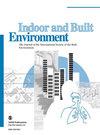Characteristics of particulate matter and polycyclic aromatic hydrocarbon pollution generated during kitchen cooking and health risk assessment
IF 2.9
3区 工程技术
Q2 CONSTRUCTION & BUILDING TECHNOLOGY
引用次数: 0
Abstract
Recent studies have shown that kitchen pollution is a major concern during cooking. Cooking can release harmful pollutants such as various sizes of particulate matters (PMs) and polycyclic aromatic hydrocarbons (PAHs) that can harm the human body directly or indirectly. This study examined the harm of pollutants from cooking in different Chinese areas, including concentrations of PMs and size distribution as well as PAHs in rural and urban locations. PMs were collected during cooking, and PAHs in the particular matter were analysed. Additionally, the study conducted pollution risk assessment and economic analysis. The results showed that PMs and PAHs released during cooking in rural kitchens were higher than in urban kitchens. Specifically, PM1.0, PM2.5 and PM10 concentrations were 5.05, 3.39 and 3.78 times higher than in rural kitchens. PAH concentration in rural kitchens was 4.79, 5.82 and 6.30 times higher than in urban kitchens, respectively. Skin contact poses the highest carcinogenic risk amongst the pathways. Females had higher exposure to carcinogens than males. Furthermore, smaller PMs have a higher adsorption capacity for PAHs and are more carcinogenic than larger particles. This study examined the harmful effects of different cooking fuels. It aimed to improve cooking environments and increase the use of clean energy.厨房烹饪过程中产生的颗粒物和多环芳烃污染的特征及健康风险评估
最近的研究表明,厨房污染是烹饪过程中的一个主要问题。烹饪可以释放有害污染物,如各种大小的颗粒物(pm)和多环芳烃(PAHs),这些污染物可以直接或间接地伤害人体。本研究调查了中国不同地区烹饪污染物的危害,包括农村和城市地区的pmms浓度和大小分布以及多环芳烃。在烹饪过程中收集pm,并分析特定物质中的PAHs。此外,本研究还进行了污染风险评估和经济分析。结果表明,农村厨房烹饪过程中释放的多环芳烃和多环芳烃含量高于城市厨房。具体而言,PM1.0、PM2.5和PM10浓度分别是农村厨房的5.05倍、3.39倍和3.78倍。农村厨房多环芳烃浓度分别是城市厨房的4.79倍、5.82倍和6.30倍。在这些途径中,皮肤接触的致癌风险最高。女性比男性更容易接触到致癌物。此外,较小的颗粒物对多环芳烃的吸附能力更高,并且比较大的颗粒物更具有致癌性。这项研究调查了不同烹饪燃料的有害影响。它旨在改善烹饪环境,增加清洁能源的使用。
本文章由计算机程序翻译,如有差异,请以英文原文为准。
求助全文
约1分钟内获得全文
求助全文
来源期刊

Indoor and Built Environment
环境科学-工程:环境
CiteScore
6.40
自引率
25.00%
发文量
130
审稿时长
2.6 months
期刊介绍:
Indoor and Built Environment publishes reports on any topic pertaining to the quality of the indoor and built environment, and how these might effect the health, performance, efficiency and comfort of persons living or working there. Topics range from urban infrastructure, design of buildings, and materials used to laboratory studies including building airflow simulations and health effects. This journal is a member of the Committee on Publication Ethics (COPE).
 求助内容:
求助内容: 应助结果提醒方式:
应助结果提醒方式:


